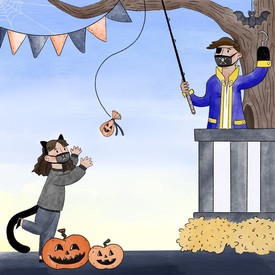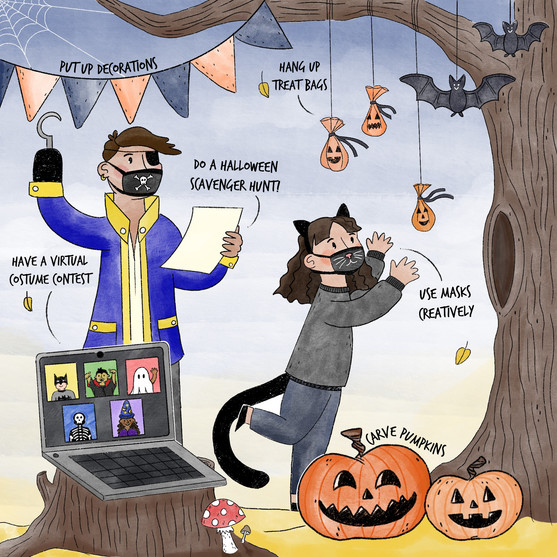Sign up for insights into DHSS's COVID-19 response
Subscribe to DHSS Insights for behind-the-scenes news about Alaska’s COVID-19 response and other efforts to protect the health and well-being of Alaskans. Stay informed and help put a lid on COVID before the snow sticks!
Resource highlights from DHSS's COVID-19 website
-
Social distancing
Keeping physically distant – at least six feet – from non-household members is one of the most important ways to prevent COVID-19.
-
Keep your social circle small - very small!
This is especially important for those who are at high risk for serious illness from COVID-19 but it's good guidance for all Alaskans right now due to community transmission occurring throughout our state.
-
Stay home if you are sick
Get tested if you feel sick at all. Stay home and isolate; don’t be around others if you are not feeling well.
- DHSS Insights
Read our blog posts for timely and interesting health and social services information including the trick-or-treating post featured in this email.
The challenge is on: Parents, this is the year to put a new spin on trick-or-treating
Celebrating holidays during a pandemic requires creative thinking and new traditions / Play Every Day update
This post was originally featured in the Play Every Day blog and developed in partnership with the department's COVID-19 response team.
OCTOBER 5, 2020 — We’re one month away from the holiday many kids — and adults — look forward to every year. And rest assured: Halloween is not canceled.
Traditional trick-or-treating with kids gathering on doorsteps isn’t recommended during the pandemic, but it’s the perfect year to try some creative ways to celebrate the day.
What about rigging a zipline from your doorstep to the end of your driveway, where a bucket drops a treat into a child’s bag?

Or stringing up a fishing pole so you can dangle treats near kids, from at least 6 feet away? Just be careful and don't use a hook.
It’s this new kind of thinking that’s going to win Halloween this year. Families who love Halloween and other holidays can and should celebrate during the pandemic. They’ll need to take a different approach, however, and come up with new ways to enjoy the day.
“It’s a great year to decorate. It’s a great year to share holiday greetings from a distance,” said Dr. Elizabeth Ohlsen, a family physician with the Alaska Department of Health and Social Services. “It’s not a great year to ring a doorbell or hand out treats from your doorstep.”
Ohlsen assures families that there are fun ways to celebrate — even trick-or-treat — that don’t involve getting too close to other people.
“I think there are ways of doing it that can still capture the joy of Halloween,” she said.
|
Should families avoid trick-or-treating during a pandemic?
For years, children have trick-or-treated by gathering in groups, going to a doorstep, ringing a doorbell and then receiving a treat from the person who answers the door. That kind of trick-or-treating isn’t recommended during a pandemic, Ohlsen said.
She recommends a new approach this year. The CDC recently published guidance on safer ways to celebrate Halloween and other holidays.
The lowest-risk way to celebrate Halloween is to dress up in costumes as a family and have a party at home with just your household. Carve pumpkins and roast the seeds, which happen to be a nutritious snack. Create a new tradition of making Halloween-themed foods and then sharing them while you watch a movie together. Or borrow a tradition from another holiday: Hide a few Halloween treats inside or outside the house and have your child find them — à la Easter egg hunting. Families nationwide are sharing ideas, like making the hunt even spookier by giving kids a flashlight to search for their treasures in the dark. More fun ideas, like scavenger hunts around your home and virtual costume contests, are found in the CDC holiday guidance.
 If your family chooses to trick-or-treat, Ohlsen recommends these changes this year: Children should only trick-or-treat with family members, not with other friends or people outside their household. They should visit houses that are prepared to deliver treats only at a distance, not from the doorstep. All children and parents who are with them should wear face coverings.
If your family chooses to welcome trick-or-treaters this year, they should minimize close contact with others. Find creative ways to deliver treats from a distance, and have children only touch the treat they’ll take. Considering clipping individual treats to a clothesline, or hanging them from a tree. Thoroughly wash or sanitize your hands before touching any treats you will give to people outside your household. Distribute only treats in wrappers, and nothing homemade, Ohlsen said.
You can make these changes and still enjoy seeing all the costumed children. Put on your face covering and sit on lawn chairs outside to watch the children pick up treats from a distance. Stand on your front porch and wave as the little ghosts and goblins pass by.
If you or a family member has COVID-19 or you may have been exposed to someone with COVID-19, don’t participate in in-person Halloween celebrations or trick-or-treat, and don’t hand out treats to children. Play Every Day also shares this suggestion to maximize the fun and minimize the sugar overload: Families can make the Halloween handoff even healthier by swapping the treat for a toy, glow-in-the-dark sticks or something else that’s not eaten.
Some families may not be comfortable with trick-or-treaters coming to their homes this year. What’s a friendly way to let children know you aren’t handing out treats?
“I think there are easy ways to signal whether a house is prepared for trick-or-treating this year, and many houses may not be,” Ohlsen said.
Turning your porch lights off lets families know you aren’t handing out treats. You also can make fun signs or arrange Halloween decorations to encourage people not to approach your doorstep.
Older kids and adults enjoy Halloween, too. Should they visit a haunted house or attend a party this year?
Indoor haunted houses and Halloween parties should be avoided because they increase chances of spreading COVID-19.
“With cases rising in our two biggest metropolitan areas, this means that gathering indoors — even with people you know who are outside your household bubble — is a very risky activity,” Ohlsen said.
There’s typically less ventilation and space for physical distancing with indoor parties than outdoor gatherings. Outdoor parties should limit attendees, allow physical distance between guests, provide ways to wash or sanitize hands and commonly touched surfaces, and require everyone to wear face coverings (not just Halloween masks), Ohlsen said. Don’t serve homemade treats, she said, and avoid sharing any foods or drinks with others.
Outdoor parties with just a few close friends, with everyone masked up and physically distanced, are the safest bet. Older kids and adults might also choose a more active option, meeting a few friends for a hike or a bike ride, in costume or riding decorated bikes. Halloween falls on a Saturday this year, so we have all day to celebrate.
Your family has a deep collection of costume masks: superheroes, pirates, ghosts. On Halloween, can you substitute those costume-style masks for the face coverings you’ve been wearing to prevent spreading COVID-19?
A typical Halloween mask doesn’t offer the same type of protection against COVID-19 that a surgical mask or fabric face covering provides. Make sure children who are trick-or-treating use a covering that provides a double layer of fabric over their nose and mouth, Ohlsen said. The CDC advises against layering a Halloween mask over a fabric face covering because that could make it harder to breathe. Instead, modify the costume so it allows the child to wear the protective face covering, Ohlsen said. Better yet: Decorate your protective face covering so it matches your costume.
Families, keep that hand sanitizer ready. Children should limit touching their masks and should use hand sanitizer before touching the mask and before and after eating any treats. Ohlsen recommended that children wait until they finish trick-or-treating to thoroughly wash their hands and then touch any contents of the bag.
Is there anything else to consider before kids dig into their bag of treats?
Currently, the CDC holiday guidance states there’s no evidence to suggest that handling food or eating is linked with directly spreading COVID-19. It’s possible that people can get COVID-19 by touching an object, like food or food packaging, that has the virus on it and then touching their mouth, nose or eyes. However, the CDC states this is not thought to be the main way that the virus is spreading. COVID-19 virus is mainly spread person-to-person.
Even so, it’s hard to know who all touched the treats in the bag by the time your child gets home from trick-or-treating, Ohlsen said. Given that, you may want to wash or sanitize your hands well and then wipe down the packaging on the treats with a disinfectant wipe or rubbing alcohol, she said. Make sure you don’t directly use cleaning chemicals, however, on anything your child will eat. After disinfecting the packaging, make sure the wrappers completely dry or are washed free of chemicals before your child touches them.
Got patience? Ohlsen said another option would be to let the bag of treats sit for a day or longer before giving them to your child.
More tips from DHSS Insights
|